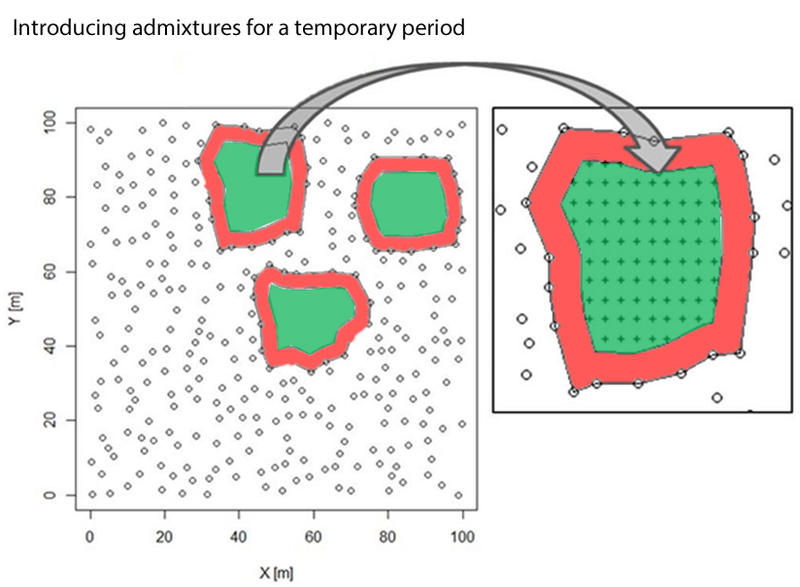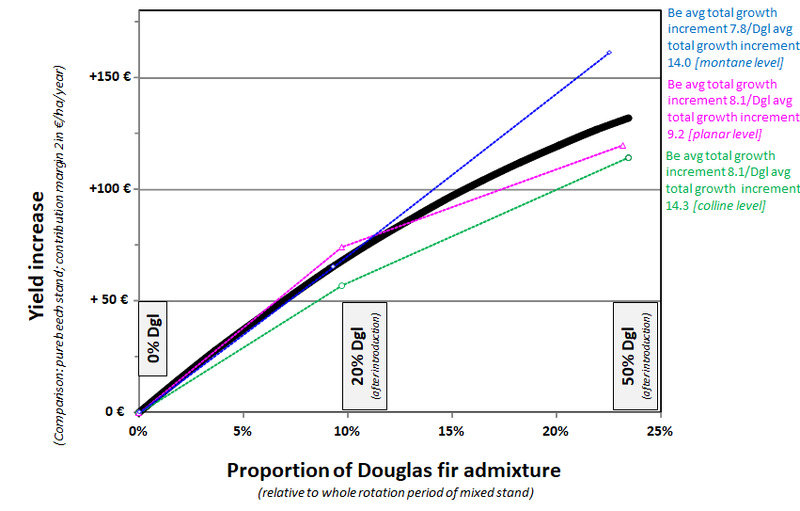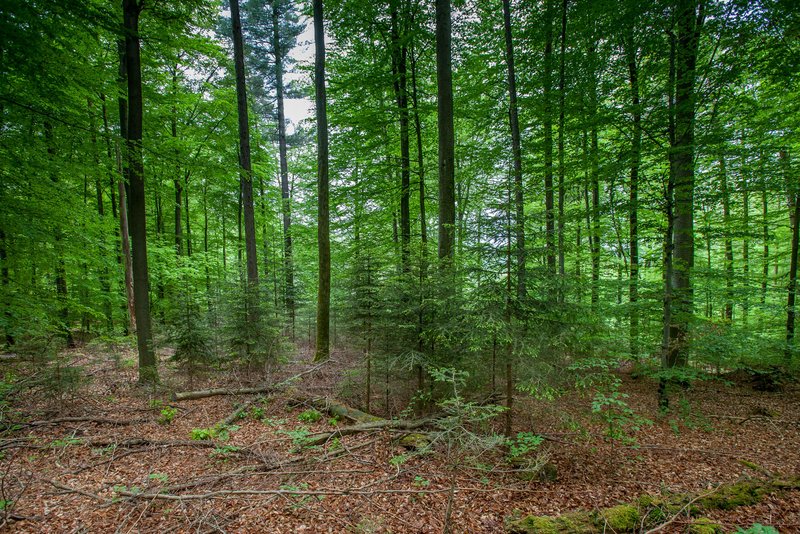Importance of coniferous species in the portfolio
Coniferous and deciduous tree species show clear differences in performance. On the one hand, the nationwide average values from the Bundeswaldinventur 3 (German national forest inventory) show that the increment in wood volume per hectare of coniferous tree species on average exceeds that of deciduous tree species by almost 50%. On the other hand, conifers are frequently exposed to comparatively higher risks - through storm, bark beetles or rot fungi, for example.
It therefore appears sensible that forest enterprises are increasingly aiming to employ mixtures of different tree species. However, these efforts are by no means fundamentally new: In Baden-Wuerttemberg, the establishment of regeneration in the form of mixed stands has been an explicit planning objective in the public forests since 1970, and binding since 1979. Against the backdrop of the uncertainties presented by climate change, this principle will clearly gain in importance.

Fig. 2: Example of a tree stand dominated by deciduos species after introduction of conifer admixtures on three subplots (proportion of total stand: 20%). The inner polygons (green) delimit the area where conifers are planted (10% of the total area). They are surrounded by a four metre wide border strip (red), in which the expanding crowns of the conifers are consistently kept free of competitors for the duration of the admixture growth period.
For the sustainable supply of raw material to the timber industry, which is mainly oriented towards the exploitation of softwood, and to cover the demand for wood in Germany, a decline in the proportion of conifers on the current scale is a challenge in the long term, because softwood is currently the most important raw material both technically and in terms of quantity.
Due to the high proportion of materially utilisable wood in conifers, they are generally also more effective than deciduous trees in terms of carbon sequestration achievable in the balance. Differences in growth vigour further reinforce this in favour of the coniferous species. The particularly vigorous growth increment of Douglas-fir can for example achieve a carbon sequestration effect that is up to +50% higher than that of beech.
In addition, the decline in the proportions of softwood in current timber yield has a serious impact on the profitability of forest enterprises. While most ecosystem services can usually best be provided with deciduous trees, the economic yield of forest enterprises, which traditionally results from timber production, still depends to a large extent on the high-growth and high-yield coniferous tree species in the companys‘ portfolio.
Timber revenues are subject to constant fluctuations and develop differently depending on the species. Revenue trends in wood are significantly influenced by developments in wood use and processing capacities. In terms of price and sales volume, conifers such as spruce and Douglas-fir continue to play the key role in constructive timber use, which is decisive for the income from timber production. In contrast, despite encouraging technical developments, beech wood for example still lacks high-quality standard products suitable for mass marketing on a larger scale.
The revenues for saw-timber in average qualities relevant for construction use (B/C) reflect these ratios between hardwoods and softwoods: For beech, this price in Baden-Wuerttemberg is a good 20% below that of spruce, and Douglas-fir is another 20% above the price of spruce. This difference is further enhanced, to the disadvantage of deciduous trees, by the significantly higher volume exploitation and saw-timber yield of conifers - under comparable site conditions - as well as the often higher harvesting costs of deciduous trees. Against this background, the economic necessity of a sufficient share of conifers in the portfolio of forest enterprises becomes clear under the current conditions.

Fig. 3: Increasing the net yield of beech stands through different proportions of temporary admixtures of Douglas-fir. The calculations apply for typical credit ratios on sites at the planar (magenta), colline (green) and montane levels (blue); the black curve shows the polynomial regression of all values (bold).
Future tree species suitability of conifers and risks
Forest management is always associated with risks. The calamities of the recent past have once again vividly demonstrated the particular risks associated with the cultivation of coniferous species. However, the history of oak dieback, elm dieback, ash dieback or the current damage to beech trees shows that deciduous trees are by no means an absolutely “safe bet”. As the risks are mostly species-specific, there is widespread agreement on the principle that a mixture of species is the best means of hedging risks.
The necessity of such considerations becomes particularly clear against the background of current developments with native coniferous tree species, in which significantly increasing risks and/or diminishing suitability are generally expected as a consequence of climate change:
The development of Norway spruce, which is currently still the major tree species in many stands, is particularly challenging. It is however considered certain that under today's climatic conditions, spruce has already lost its suitability as the leading main tree species on many sites throughout Germany - or will lose it in the foreseeable future.
In the case of silver fir, too, we see a decline in its suitability as a result of climate change, although it is not quite as dramatic as in the case of spruce.
Although Scots pine is considered less demanding in terms of its water requirements, it is obviously sensitive to high temperatures, so that considerable losses or damage to this species can occur regularly, especially after hot spells.
In the case of the native conifers, it can therefore be assumed that they will lose their suitability as the leading tree species on many sites throughout Germany, and that in future it would seem sensible to plant them in most cases only in the form of admixtures.
The principle of best using mixed-stands also applies to Douglas-fir. However, compared with spruce and fir, Douglas-fir may be less strongly affected by climate change. Where suitable site conditions exist, it therefore often offers a medium-term alternative from the point of view of timber production. However, Douglas-fir is not a climatic “miracle tree”, either. If climate change continues to progress, increasing risks are also to be expected for this species, as is already evident today on particularly dry and warm sites.
Temporary admixtures as a compromise between risk and return
In temporary admixing, (highly) productive coniferous species are included in the establishment of the stand, making up low proportions of the total number of trees. Temporary admixtures are a good means of at least partially easing the operational dilemma presented by having to decide between low-yielding but relatively stable tree species on the one hand, and higher-risk but high-yielding tree species on the other. They limit the increasing risk potential of productive coniferous species in times of climate change thanks to the lower proportion of the coniferous species involved and shorter production times. In this way they increase the productivity of stands of low-yielding tree species without compromising their stability, closeness-to-nature, or provision of ecosystem services in the long term.
The choice of a suitable mixture of species is of central importance. Depending on the light requirements of the conifer species to be introduced and the spacing requirements in the mature stand, gaps must have a minimum size. On the one hand, gap size should ensure the growth of the conifers, and on the other hand, should also allow the surrounding deciduous tree population sufficient space for further crown development after the coniferous tree species have been removed.
For the introduction of spruce, this lower limit in gap size is a minimum of around 0.1 ha. The introduction of Douglas-fir, which requires more light, only appears to make sense where gaps are significantly larger. In particular in areas where only small gaps have been created as a result of damage, these minimum spacing requirements should be strictly observed. In smaller gaps, only more shade-tolerant tree species should be introduced into the stand - however, here it may well often be economically more sensible to refrain altogether from artificial regeneration measures.
On larger damaged areas, these restrictions resulting from the light requirements of the tree species to be introduced do not apply in principle, as the mature stands have disappeared here. Nevertheless, for maintenance and management reasons, it appears reasonable not to introduce the admixtures over too small an area. In general, area sizes of at least 0.1 to 0.2 ha (diameter 30 to 40 m) should be appropriate.
The recently completed joint project carried out by UNIQUE forestry and land use and the FVA on “Increasing land productivity and value creation in beech forests”, funded by the Federal Ministry of Food and Agriculture (BMEL), shows in an exemplary way how effectively such temporary admixtures of productive coniferous species could at least contribute to securing the yield of forest enterprises and the supply of raw materials to the timber industry in times where proportions of softwood timber are decreasing (see PDF information on the project and literature).
Maintenance and development of temporary admixtures
In principle, the tending recommendations for the “regular” introduction of permanent admixtures of productive coniferous species into deciduous natural regeneration also apply to temporary admixtures. These include effective protection against damage by game, as well as suitably intensive tending of the young stand to keep the introduced conifers clear of excessive competition from natural regeneration during the establishment phase.
Protection against damage caused by game is particularly essential in temporary admixtures with productive coniferous species. In comparison, removing of competitors surrounding the conifers plays a much less decisive role in fact. Moreover, it is usually only necessary when the competing natural regeneration begins to exceed the introduced conifers in height. It should also be borne in mind that removing competing vegetation also renders the conifers more accessible to game and thus increases their risk.
It should also be noted in this context that the use of tree tubes for Douglas-fir - also for protection against game, for example - should be assessed critically: A summary of the extensive findings of a recently presented systematic practical study concludes that the use of tree tubes for Douglas-fir, for example, cannot be recommended from a silvicultural point of view. The environmentally critical aspects of the use of tree tubes should also be considered.
The bottom line
Securing the supply of sufficient proportions of productive, adaptable coniferous species is - at least in the medium term - an important concern of the forestry and timber industries. The reforestation of damaged areas offers opportunities in this respect. However, this is only the case if the challenges of adapting to climate change can be incorporated as a central element in the reforestation measures at the respective site. This applies above all to aspects relating to the choice of tree species, provenances and forms of mixtures.
In connection with the current reforestation of damaged areas, the integration of temporary admixtures provides interesting possibilities for the design of the future tree species portfolio of yield-oriented forest enterprises. This is because this removes some restrictions on the damaged areas that make the introduction of productive conifers into broadleaf stands difficult within the framework of “regular” management, such as the availability of sufficient levels of light.
However, classical silvicultural solutions and concepts (alone) will no longer be sufficient to answer the questions posed when it comes to reforestation of the damaged areas in times of climate change. Not least for this reason, potential alternatives in tree species selection are currently the subject of much debate in both research and practice.
In conclusion, it should be emphasised that the success and functionality of temporary admixtures depend decisively on the following factors:
- The conifers must reach harvesting maturity quickly through continuous tending. To this end, diameter development must be intensively promoted by consistent high thinning - preferably in the form of a plus-tree thinning - in order to achieve the desired (moderate) target diameter without unnecessary delay.
- When they reach harvesting maturity, the conifers must then actually be removed from the stand quickly.
To prevent misunderstandings in this context: Extension of the production period of the conifers through hesitant utilisation or by retrospectively raising the target diameter would be downright counterproductive. This would not only be extremely detrimental to the explicit goal of hedging risks, but would also make no sense in terms of economic yield, due to the (branch) qualities produced. In addition to jeopardising potential yields, it could also have a negative effect on other aspects of ecosystem services.


![[Translate to English:] [Translate to English:]](/assets/_processed_/4/3/csm_va_wiederbewaldung_sturmwurfflaechen_36_abb3.jpg_495e2c4595.jpeg)